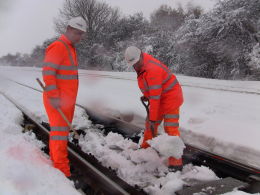Posted 22nd December 2010 | 1 Comment
Weather threatens to trigger Network Rail overspends

THE early onset of winter, and forecasts that the freezing conditions could last for some time, are threatening to trigger unplanned overspends at Network Rail.
The company had invested in additional winterisation measures, including 3,000 new conductor rail heaters which have been installed at vulnerable locations in Kent. First reports suggest that the heaters have been helping, and more installations are being considered on other parts of the third rail network in counties like Sussex and Hampshire.
But as the Arctic winter closes in, the cost of keeping the main network open at night is starting to mount up.
As many as 5,000 people have been on duty in the small hours, working to keep points and conductor rails clear, but the additional paybill has already run into seven figures, with no respite in prospect.
Network Rail is under orders from the Office of Rail Regulation to contain its spending, and its annual budgets are set to fall regularly during the rest of Control Period 4, which started in 2009 and runs until 2014.
Steve Featherstone, who is Network Rail’s director of infrastructure maintenance, said the recent bad weather had already added more than a million pounds to his outgoings, to pay for the extra cold weather staffing.
MORE: click here for the full story in the new edition of Railnews FOCUS
Also in FOCUS for December:
David Quarmby criticises shortcomings by TOCs over bad weather information
HS2: now the route is known, we reveal that most objectors live near it
‘Stark solutions’ may be necessary to deal with South East rail growth
Sir Roy McNulty: how the railway can save £1 billion
Download the new edition now
Reader Comments:
Views expressed in submitted comments are that of the author, and not necessarily shared by Railnews.

Bill Dickson, Millom, UK
This sort of spending comes out of contingency funds which are, in well managed companies, reserved for just such events which are not able to be predicted by accountants. If not enough resides in these funds, then the accountants are not being cautious enough in this instance.